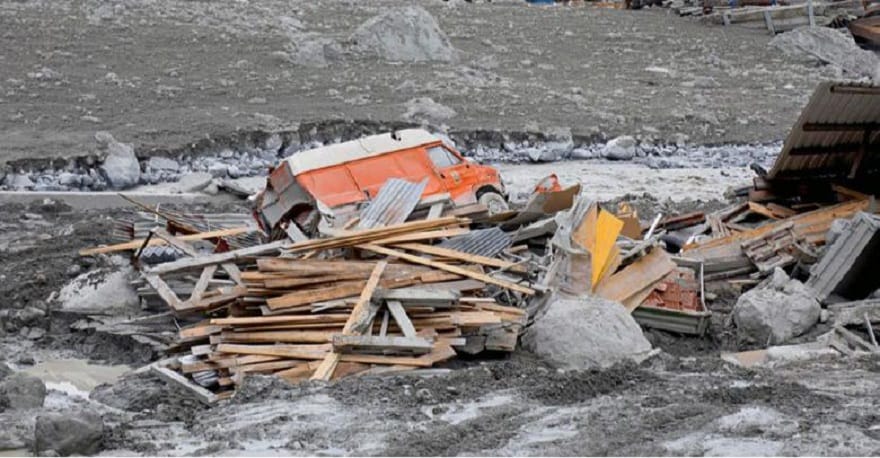Complex and costly, but valuable
Even if the costs of protection against natural hazards are borne by several partners in the network, the sum involved is considerable: according to recent estimates, Switzerland spends almost three billion Swiss francs on this every year. It is therefore all the more important to use the funds to the best possible effect. This requires risk management that takes the complex interrelationships into account.

The fact that the Bondo landslide a good two and a half years ago went relatively smoothly is not just down to chance: when three million cubic metres of rock broke away from Pizzo Cengalo on 23 August 2017 and set heavy debris flows in motion along the Bondasca, the specially installed monitoring system - cameras, level radar, ripcord - sounded the alarm for the first time. The newly built catchment basin with its massive concrete wall facing the village fulfilled its purpose and saved Bondo from major devastation; the population was evacuated in good time. The protective measures were effective.
As a mountainous country, Switzerland has a long tradition of dealing with natural hazards. Rockfalls and debris flows, as in the Bondo case, are just two of numerous other natural hazards which, according to the definition of the Federal Office for the Environment (FOEN), are to be understood as processes in nature that can be harmful to people, material assets and the environment. Based on relief, climate and tectonics, three basic hazard groups are distinguished for Switzerland: gravitational hazards, which include floods or mass movements, climatic-meteorological hazards, which include storms, heavy rain, hail and drought, and tectonic hazards, which focus on earthquakes.
In Switzerland, protection against natural hazards is thus a distinctly interconnected task. The division of tasks is initially based on the principles of self-responsibility and subsidiarity: While private actors (households, companies, infrastructure operators) are primarily responsible for individual property protection and insurance companies (cantonal building insurers, private providers) provide financial cover for possible damage, the public sector - supported by research and engineering - is primarily responsible for collective protection and prevention tasks. Nationwide, regional and local tasks are assigned to the federal, cantonal and municipal levels accordingly.1 This federalist practice also includes ensuring that the burdens are appropriately balanced between regions that are affected differently.
From hazard prevention to integral risk management
While protection concepts in Switzerland have long concentrated on the defence against individual natural hazards, it has recently become accepted that effective and at the same time resource-conserving protection is better achieved if the complex interactions in dealing with natural hazards are systemically addressed and tackled. Three directions are important:
Firstly, the focus should no longer be on the objective natural event, but on the risk induced by it. In this context, risk (R) is understood as the result of the probability (P) of a certain event and the possible damage (S), which in turn results from the extent of persons and property at risk (W) and their exposure (E) and vulnerability (V): R = ƒ (P, S); S = ƒ (W, E, V). This shows clearly (for unchanged P, E and V) that the risks from natural hazards in Switzerland have increased in recent decades simply because land use and thus the damage potential have increased massively (built-up area 1985-2009: +23 %).
Secondly, risks should be systematically recorded, assessed and managed. The following key questions are decisive: - What can happen?
On the basis of scientific analyses, the relevant natural hazards are identified and evaluated according to their probability and intensity.
Hazard maps show which settlement areas and infrastructures are affected. They also provide the overall view that is essential for risk-based protective measures, particularly in spatial planning. - What can happen?
Based on the risk analysis, the tolerance threshold is determined: Which risk is acceptable, which is too high? The need for protection depends essentially on the level of protection: if people or high material assets are at risk, the tolerance must be set lower and the protection target higher. Such questions usually have to be decided collectively, whereby the answer also depends on the willingness of the individual to assume personal responsibility. - What is to be done?
Finally, the need for protection is used to plan the package of measures, which should bring the risks below the tolerance threshold and be proportionate: Local needs or conflicting objectives are taken into account, as is the basic economic rule that the costs must not exceed the overall benefits. The planning of measures is always an optimisation process.
Thirdly, this leads to integrated action planning that optimally combines the various instruments and interventions in awareness of their systemic interactions: it extends from event preparation (prevention, preparedness) through management (warning, response) to regeneration (reconstruction, learning), relates local, regional, national and sometimes global levels of action and at the same time takes account of the requirements of sustainable development.
These three programmatic points mark, as it were, the path towards Integrated Risk Management (IRM), which the main players in the protection against natural hazards embarked upon a few years ago.
Strategy 2018: Fields of action
In recent years, considerable progress has been made in IRM in various fields of activity, such as hazard maps for floods and mass movements, forecasting, warning and alerting, and the protection of critical infrastructures. In operational risk management, which deals with the planning and implementation of individual protection projects, Switzerland has been excellently positioned for years.
However, according to federal experts, there are still some significant gaps in the current system that need to be closed in the coming years,2 for example in the area of standards, data bases and models that are indispensable for quantifying and mapping risks in nationwide overviews. Not least because of this, the efficiency potential of risk-based planning of measures and resources cannot be optimally exploited at present. The fact that those affected by risk are often insufficiently informed about natural hazards, risks and individual prevention shows that further action is needed if all forces are to be optimally involved in protection against natural hazards.
The updated PLANAT Strategy 20183 addresses these and numerous other deficits systematically. The aim is to increase Switzerland's resilience, its ability to withstand, regenerate and adapt to climate change.
further strengthen natural hazards. In view of the more distinct contours of climate change and its further accentuation - especially in the mountainous country of Switzerland - these efforts do not come too soon.









